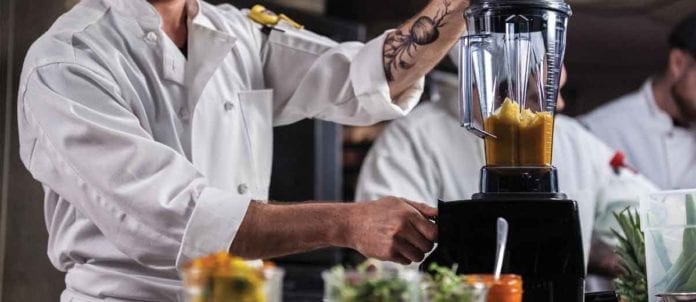The myth is that the Waring blender was developed by Fred Waring, a musician who liked milkshakes so much he invented a machine for when he was on tour. At the time, the 1930s, blenders had small jars and low power and stayed that way until fairly recently.
“Things really started to change 15 years ago,” says Paul Leclerc of Serve Canada Food Equipment, a specialty food-equipment company based in Richmond Hill, Ont. “Where you had 1/2-horsepower (hp) blenders, it’s now common to have two hp; where you had r.p.m. of 12,000, now you have blenders that are up to 45,000 r.p.m. Where blenders were once used to only mix ingredients, they are now making peanut butter from scratch and taking flax seed down to flax flour.”
Bigger is Better
The blender market is a busy one. With four or five major brands within the industry, it’s not a sector where change is radical — or often — but improvements do occur in response to trends in the industry. “The evolution in blenders has been power,” Leclerc says. “But ultimately, it’s a jar on a base with a blade assembly.” Treated properly and maintained correctly, a good commercial blender can last 10 to 15 years, depending on what you put in it. Blenders can be targeted for specific uses because blades and blade systems have evolved for foods or frozen beverages. Some do both, Leclerc says, noting if you’re only going to blend a few ingredients or make the odd soup, you may need less power; frozen drinks, on the other hand, would need more power. “One of the rules,” Leclerc points out, “is the better the blender, the faster the blend.”
When it comes to jar size, blenders can have 32-oz. jars up to 64-oz. As for construction materials, while BPA-free polycarbonate is popular, glass is not practical and stainless steel is ultimately the best. However, at Waterloo’s Thrive Energy Lab, owner Jonnie Karan loves the 1,500 watts of power in his BlendTec. It has multiple programmable settings and several speeds for making approximately 100 smoothies a day on machines that have logged more than 50,000 runs, Karan estimates. The small restaurant and juice bar uses three blenders with a fourth utilized for other food prep. He says he considered three models, but prefers the plastic jug over glass.
“If you drop a glass one in a busy kitchen, it’s pretty expensive,” Karan says. “[Plastic is] lighter and quicker to use, as well as easier to wash.”
He selected the brand because he found the design suitable for fast smoothie production and lacks a tamper, which hinders speed of use, he says. “I find BlendTec is designed around smoothies. There are amazing machines out there, but they can be expensive.” A drawback for Karan is the fact that jug and blade assembly are single construction. “The steel goes, and it always does, so then you have to throw away the entire jug. I don’t like having to do that.”
Accordingly, the purchasing process always comes down to quality, knowing your ingredients and knowing what your blender can offer, says Ben Schach, co-founder of Vancouver-based Glory Juice Co. “People are craving healthy options that are convenient — whether that’s juice, smoothies or food,” he says, adding that Glory Juice purchased a VitaMix for power and functionality. “It’s a quiet version that works well for our store design and because we don’t use ice. We’re all fruit-based and all whole-food smoothies. We went with what we thought was the highest-quality blender.”
All Juiced Up
Juicers come in two basic types — higher speed, centrifugal juicers and slower “cold-press” masticating models. The primary difference is speed, with a low-speed juicer below 100 r.p.m. With a high-speed juicer, the juice product is typically good for about 30 minutes in order to ensure full nutritional value. Slow juicers prepare food that is fully nutritional for upwards of 72 hours. The proof is in the pulp: high-speed juicers release a wetter pulp, while masticating juicers result in a dry pulp.
Kevin Keith, national project manager at Robot Coupe USA, has three tips for buying a juicer. First, make sure it’s a commercial-rated product and can work day-in and day-out; consider name recognition, which can be synonymous with quality; and consider whether you require continuous output of product. He says a benefit of the Robot Coupe J-80 Ultra ($2,306) and J-100 Ultra ($2,882) juicers is that they require no tools for assembly and disassembly.
“Other products on the market require what looks like a lug wrench,” says Keith. “We wanted to create a juicer that was user friendly.” Thrive Energy Lab uses two Robot Coupe J-80 Ultra centrifugal juicers. “They’re phenomenal,” Karan says. “They’re really well built and will juice anything you put through it.” That includes heavier root vegetable such as beets and carrots, as well as apples and pears. “They shred the product and then centrifugal force separates the pulp from the juice.” They also use a non-commercial Omega 8006 masticating juicer. “It produces a good juice yield and does the trick for us for $300. I’ve used them all, including the Angel [Juicer], but some are very big and not something you can keep on the counter.”
Volume 50, Number 4
Written by Andrew Coppolino


















